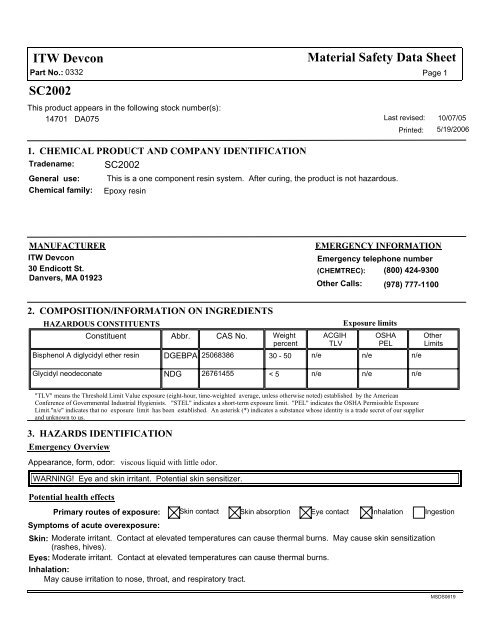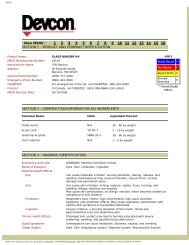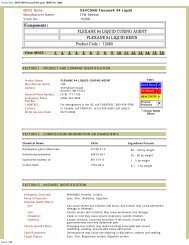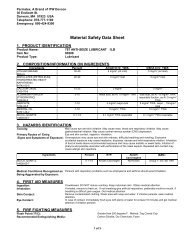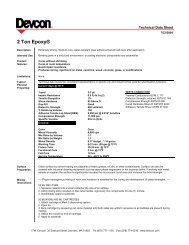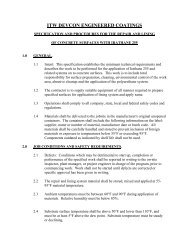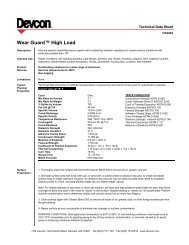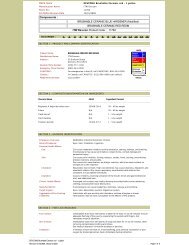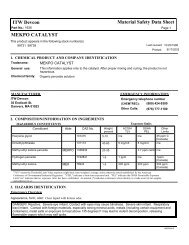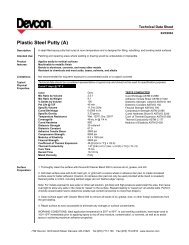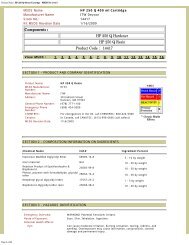SC2002 ITW Devcon Material Safety Data Sheet
SC2002 ITW Devcon Material Safety Data Sheet
SC2002 ITW Devcon Material Safety Data Sheet
Create successful ePaper yourself
Turn your PDF publications into a flip-book with our unique Google optimized e-Paper software.
<strong>ITW</strong> <strong>Devcon</strong><br />
Part No.: 0332<br />
<strong>SC2002</strong><br />
This product appears in the following stock number(s):<br />
14701 DA075<br />
<strong>Material</strong> <strong>Safety</strong> <strong>Data</strong> <strong>Sheet</strong><br />
Page 1<br />
Last revised: 10/07/05<br />
Printed: 5/19/2006<br />
1. CHEMICAL PRODUCT AND COMPANY IDENTIFICATION<br />
Tradename: <strong>SC2002</strong><br />
General use: This is a one component resin system. After curing, the product is not hazardous.<br />
Chemical family: Epoxy resin<br />
MANUFACTURER<br />
<strong>ITW</strong> <strong>Devcon</strong><br />
30 Endicott St.<br />
Danvers, MA 01923<br />
EMERGENCY INFORMATION<br />
Emergency telephone number<br />
(CHEMTREC): (800) 424-9300<br />
Other Calls: (978) 777-1100<br />
2. COMPOSITION/INFORMATION ON INGREDIENTS<br />
HAZARDOUS CONSTITUENTS<br />
Constituent<br />
Abbr.<br />
CAS No.<br />
Weight<br />
percent<br />
ACGIH<br />
TLV<br />
Exposure limits<br />
Bisphenol A diglycidyl ether resin DGEBPA 25068386 30 - 50 n/e<br />
n/e<br />
Glycidyl neodeconate NDG 26761455 < 5 n/e<br />
n/e<br />
OSHA<br />
PEL<br />
n/e<br />
n/e<br />
Other<br />
Limits<br />
"TLV" means the Threshold Limit Value exposure (eight-hour, time-weighted average, unless otherwise noted) established by the American<br />
Conference of Governmental Industrial Hygienists. "STEL" indicates a short-term exposure limit. "PEL" indicates the OSHA Permissible Exposure<br />
Limit."n/e" indicates that no exposure limit has been established. An asterisk (*) indicates a substance whose identity is a trade secret of our supplier<br />
and unknown to us.<br />
3. HAZARDS IDENTIFICATION<br />
Emergency Overview<br />
Appearance, form, odor: viscous liquid with little odor.<br />
WARNING! Eye and skin irritant. Potential skin sensitizer.<br />
Potential health effects<br />
Primary routes of exposure:<br />
Symptoms of acute overexposure:<br />
Skin contact Skin absorption Eye contact Inhalation Ingestion<br />
Skin: Moderate irritant. Contact at elevated temperatures can cause thermal burns. May cause skin sensitization<br />
(rashes, hives).<br />
Eyes: Moderate irritant. Contact at elevated temperatures can cause thermal burns.<br />
Inhalation:<br />
May cause irritation to nose, throat, and respiratory tract.<br />
MSDS0619
<strong>ITW</strong> <strong>Devcon</strong><br />
Part No.: 0332<br />
<strong>Material</strong> <strong>Safety</strong> <strong>Data</strong> <strong>Sheet</strong><br />
Page 2<br />
Ingestion:<br />
May cause gastric distress.<br />
Effects of chronic overexposure:<br />
Prolonged or repeated skin contact may cause an allergic skin reaction or sensitization, with itching, swelling, or<br />
rashes on later exposure.<br />
Carcinogenicity -- OSHA regulated: No ACGIH: No National Toxicology Program: No<br />
International Agency for Research on Cancer: No<br />
Medical conditions which may be aggravated by exposure:<br />
Preexisting eye and skin disorders (e.g. eczema). Development of preexisting skin or lung allergy symptoms may<br />
increase.<br />
Other effects:<br />
See section 11.<br />
4. FIRST AID MEASURES<br />
First aid for eyes:<br />
Flush eye with clean water for at least 15 minutes while gently holding eyelids open. Get immediate medical<br />
attention.<br />
First aid for skin:<br />
Immediately remove contaminated clothing and excess contaminant. Flush skin with water. Wash thoroughly with<br />
soap and warm water. Consult a physician if irritation develops.<br />
First aid for inhalation:<br />
Remove patient to fresh air. Administer oxygen if breathing is difficult. Get medical attention if symptoms persist.<br />
First aid for ingestion:<br />
Do NOT induce vomiting. Give two glasses of water to dilute if patient is conscious. Get medical attention.<br />
5. FIRE FIGHTING MEASURES<br />
Extinguishing media:<br />
Water<br />
Flash Point (°F): > 200<br />
Method: PMCC<br />
Explosive limits in air (percent) -- Lower: n/d<br />
Carbon dioxide Dry chemical Foam Alcohol foam<br />
Upper: n/d<br />
Special firefighting procedures:<br />
<strong>Material</strong> will not burn unless preheated. Do not enter confined space without full bunker gear. Firefighters should<br />
wear self-contained breathing apparatus and protective clothing. Cool fire exposed containers with water.<br />
Unusual fire and explosion hazards:<br />
Heating above 300 deg F in the presence of air may cause slow oxidative decomposition and above 500 deg F may<br />
cause polymerization.<br />
Hazardous products of combustion:<br />
When heated to decomposition it emits fumes of Cl- , carbon monoxide, other fumes and vapors varying in<br />
composition and toxicity.<br />
6. ACCIDENTAL RELEASE MEASURES<br />
Spill control:<br />
Avoid personal contact. Eliminate ignition sources. Ventilate area.<br />
MSDS0619
<strong>ITW</strong> <strong>Devcon</strong><br />
Part No.: 0332<br />
<strong>Material</strong> <strong>Safety</strong> <strong>Data</strong> <strong>Sheet</strong><br />
Page 3<br />
Containment:<br />
Dike, contain and absorb with clay, sand or other suitable material.<br />
Cleanup:<br />
For large spills, pump to storage/salvage vessels. Soak up residue with an absorbent such as clay, sand, or other<br />
suitable material and dispose of properly. Flush area with water to remove trace residue.<br />
Special procedures:<br />
Prevent spill from entering drainage/ sewer systems, waterways, and surface waters.<br />
7. HANDLING AND STORAGE<br />
Handling precautions:<br />
Avoid contact with skin, eyes, or clothing. Wash thoroughly with soap and water after using and particularly before<br />
eating, drinking, smoking, applying cosmetics, or using toilet facilities.<br />
Launder contaminated clothing and protective gear before reuse. Discard contaminated leather articles.<br />
Provide appropriate ventilation/respiratory protection against decomposition products (see Section 10) during<br />
welding/flame cutting operations and to protect against nuisance dust during sanding/grinding of cured product.<br />
Storage:<br />
Store in a cool, dry area in closed containers away from high temperatures and flames.<br />
8. EXPOSURE CONTROLS/PERSONAL PROTECTION<br />
Engineering controls<br />
Ventilation :<br />
Local exhaust ventilation is preferred although good general mechanical ventilation is usually adequate for most<br />
industrial applications. Local exhaust is recommended for confined areas.<br />
Other engineering controls :<br />
Have emergency shower and eye wash available.<br />
Personal protective equipment<br />
Eye and face protection:<br />
<strong>Safety</strong> glasses with side shields.<br />
Skin protection:<br />
Chemical-resistant gloves and other gear as required to prevent skin contact.<br />
Respiratory protection:<br />
None needed in normal use with proper ventilation. In poorly ventilated areas use NIOSH approved organic vapor<br />
cartidge respirator for uncured resin, dust/particle respirator during grinding/sanding operations for cured resin, or<br />
fresh airline respirator as exposure levels dictate (see OSHA 1910.134).<br />
MSDS0619
<strong>ITW</strong> <strong>Devcon</strong><br />
Part No.: 0332<br />
<strong>Material</strong> <strong>Safety</strong> <strong>Data</strong> <strong>Sheet</strong><br />
Page 4<br />
9. PHYSICAL AND CHEMICAL PROPERTIES<br />
Specific gravity: 1.64<br />
Melting point (°F):<br />
n/d<br />
Vapor pressure (mmHg): n/d at 171 °F<br />
VOC (grams/liter): 0<br />
Percent volatile by volume: 0<br />
Percent solids by weight: 100<br />
Boiling point (°F): >200<br />
Vapor density (air = 1): >1<br />
Evaporation rate (butyl acetate = 1): n/d<br />
Solubility in water:<br />
Negligible<br />
pH (5% solution or slurry in water): n/d<br />
10. STABILITY AND REACTIVITY<br />
This material is chemically stable.<br />
Hazardous polymerization will not occur.<br />
Conditions to avoid :<br />
Open flame and extreme heat<br />
Incompatible materials:<br />
Strong Lewis or mineral acids, strong oxidizing agents, strong mineral and organic bases (especially primary and<br />
secondary aliphatic amines).<br />
Hazardous products of decomposition:<br />
Oxides of carbon and nitrogen; aldehydes, acids and other organic substances may be formed during combustion or<br />
elevated temperature (>500 deg F) degradation.<br />
Conditions under which hazardous polymerization may occur:<br />
Heat is generated when resin is mixed with curing agents; Run-a-way cure reactions may char and decompose the<br />
resin, generating unidentified fumes and vapors which may be toxic.<br />
11. TOXICOLOGICAL INFORMATION<br />
Acute oral effects:<br />
LD50 (rat): Not available.<br />
Acute dermal effects:<br />
LD50 (rabbit): Not available.<br />
Acute inhalation effects: LC50 (rat): Not available. Exposure: 8 hours.<br />
Eye irritation:<br />
No data available.<br />
Subchronic effects:<br />
No data available.<br />
Carcinogenicity, teratogenicity, and mutagenicity:<br />
1) MUTAGENICITY: Liquid resins based on diglycidyl ether of Bisphenol A (DGEBPA), have proved to be inactive<br />
when tested by in vivo mutagenicity assays. These resins have shown activity in in vitro microbial mutagenicity<br />
screening and have produced chromosomal aberrations in cultured rat liver cells. The significance of these tests to<br />
MSDS0619
<strong>ITW</strong> <strong>Devcon</strong><br />
Part No.: 0332<br />
<strong>Material</strong> <strong>Safety</strong> <strong>Data</strong> <strong>Sheet</strong><br />
man is unknown. 2) CARCINOGENICITY: Recent 2-year bioassays in rats and mice exposed by the dermal route to<br />
DGEBPA yielded no evidence of carcinogenicy to the skin or any other organs. This study clarifies prior equivocal<br />
results from a 2-year mouse skin painting study, which were suggestive, but not conclusive, for weak carcinogenic<br />
activity. 3) The International Agency for Research on Cancer (IARC) concluded that DGEBPA is not classifiable as a<br />
carcinogen (IARC group 3), that is human and animal evidence of carcinogenicy is inadequate. NPGDGE produced<br />
skin tumors in mice when repeatedly applied to skin at doses of 1.87 and 3.75 mg/mouse/week for 2 years. Was<br />
positive in bacterial genetic toxicity assays. Mixed results in mammalian toxicity assays. Carbon black has been<br />
shown to have In Vivo mutagenic effects on a rat lung cells.<br />
Other chronic effects:<br />
Prolonged or repeated skin contact may cause sensitization, with itching, swelling, or rashes on later exposure.<br />
Studies have shown bisphenol A diglycidyl ether resin to cause allergic contact dermititis.<br />
Page 5<br />
Toxicological information on hazardous chemical constituents of this product:<br />
Constituent<br />
Oral LD50<br />
(rat)<br />
Dermal LD50<br />
(rabbit)<br />
Inhalation LC50<br />
4hr, (rat)<br />
Bisphenol A diglycidyl ether resin 11.4 g/kg >20 ml/kg no deaths<br />
Glycidyl neodeconate 9.6 g/kg (rat) 3.8 g/kg (rat) N/A<br />
12 ECOLOGICAL INFORMATION<br />
Ecotoxicity:<br />
No data available.<br />
Mobility and persistence:<br />
No data available.<br />
Environmental fate:<br />
No data available.<br />
'n/d' = 'not determined'<br />
13. DISPOSAL CONSIDERATIONS<br />
Please see also Section 15, Regulatory Information.<br />
Waste management recommendations:<br />
If this product becomes a waste, it would not be a hazardous waste by RCRA criteria (40CFR 261). Dispose of<br />
according to applicable federal, state, and local regulations.<br />
MSDS0619
<strong>ITW</strong> <strong>Devcon</strong><br />
Part No.: 0332<br />
14. TRANSPORT INFORMATION<br />
<strong>Material</strong> <strong>Safety</strong> <strong>Data</strong> <strong>Sheet</strong><br />
Page 6<br />
Proper shipping name: Non-regulated<br />
Technical name :<br />
N/A<br />
Hazard class :<br />
N/A<br />
UN number:<br />
N/A<br />
Packing group:<br />
N/A<br />
Emergency Response Guide no.: N/A<br />
IMDG page number: N/A<br />
Other:<br />
N/A<br />
ORM-D : N/A<br />
LtdQty : N/A<br />
15. REGULATORY INFORMATION<br />
U.S. Federal Regulations<br />
TSCA<br />
All : ingredients of this product are listed, or are exempt from listing, on the TSCA inventory.<br />
The following RCRA code(s) applies to this material if it becomes waste:<br />
None<br />
Regulatory status of hazardous chemical constituents of this product:<br />
Constituent<br />
Extremely<br />
Hazardous*<br />
Toxic<br />
Chemical**<br />
CERCLA<br />
RQ (lbs)<br />
TSCA 12B Export<br />
Notification<br />
Bisphenol A diglycidyl ether resin No No 0.0 Not required<br />
Glycidyl neodeconate No No 0.0 Required<br />
*Consult the appropriate regulations for emergency planning and release reporting requirements for substances on the SARA Section 301<br />
Extremely Hazardous Substance list.<br />
**Substances for which the "Toxic Chemical" column is marked "Yes" are on the SARA Section 313 list of<br />
Toxic Chemicals, for which release reporting may be required. For specific requirements, consult the appropriate regulations .<br />
For purposes of SARA Section 312 hazardous materials inventory reporting, the following hazard<br />
classes apply to this material: - Immediate health hazard -- Delayed health hazard -<br />
Canadian regulations<br />
WHMIS hazard class(es) : D2B; D2A<br />
MSDS0619
<strong>ITW</strong> <strong>Devcon</strong><br />
Part No.: 0332<br />
<strong>Material</strong> <strong>Safety</strong> <strong>Data</strong> <strong>Sheet</strong><br />
Page 7<br />
16. OTHER INFORMATION<br />
Hazardous <strong>Material</strong>s<br />
Identification System (HMIS)<br />
ratings:<br />
Health<br />
2*<br />
Flammability<br />
1<br />
Reactivity<br />
1<br />
The information and recommendations in this document are based on the best information available to us at the time of preparation, but we make no<br />
other warranty, express or implied, as to its correctness or completeness, or as to the results of reliance on this document.<br />
MSDS0619


